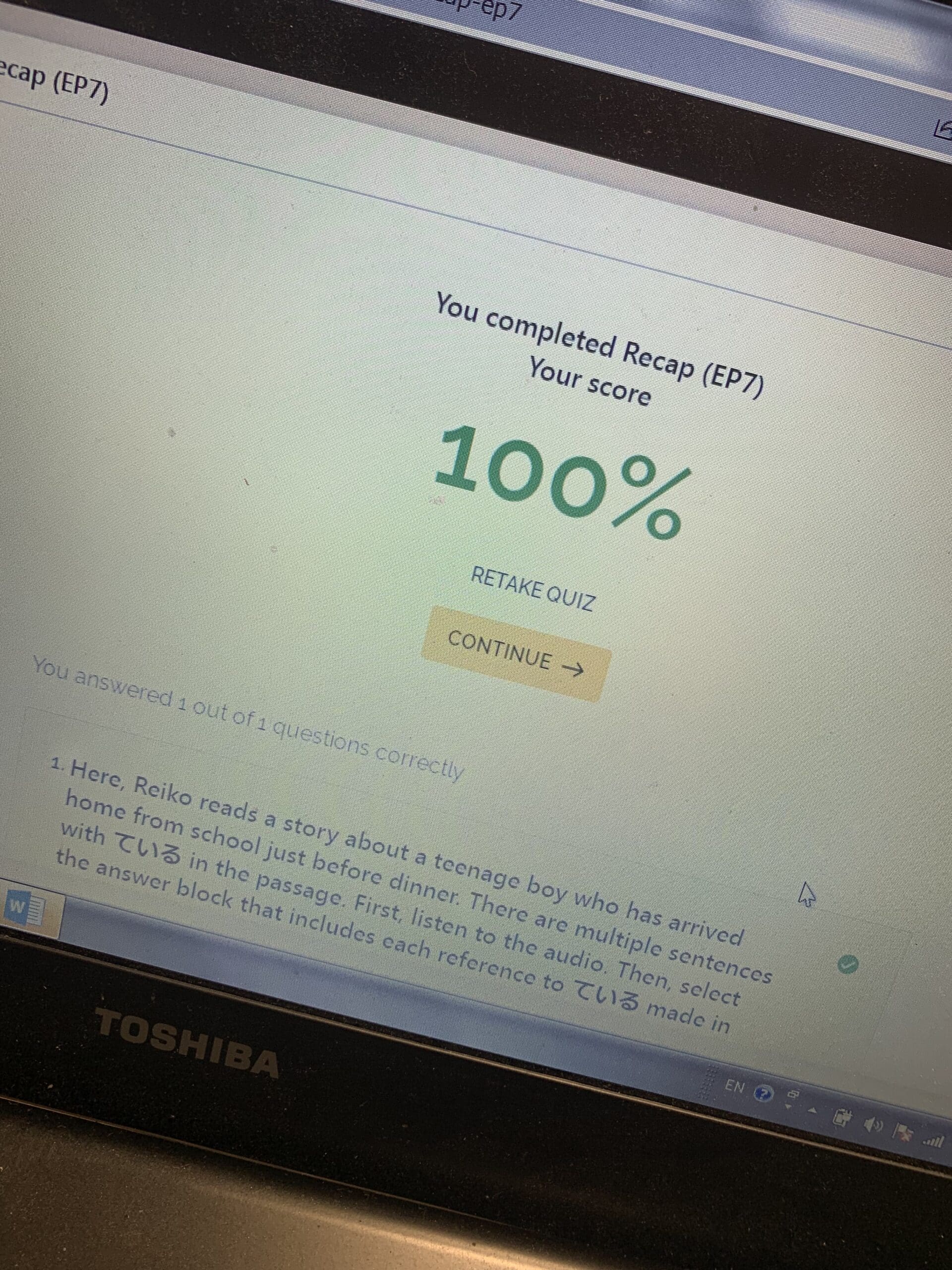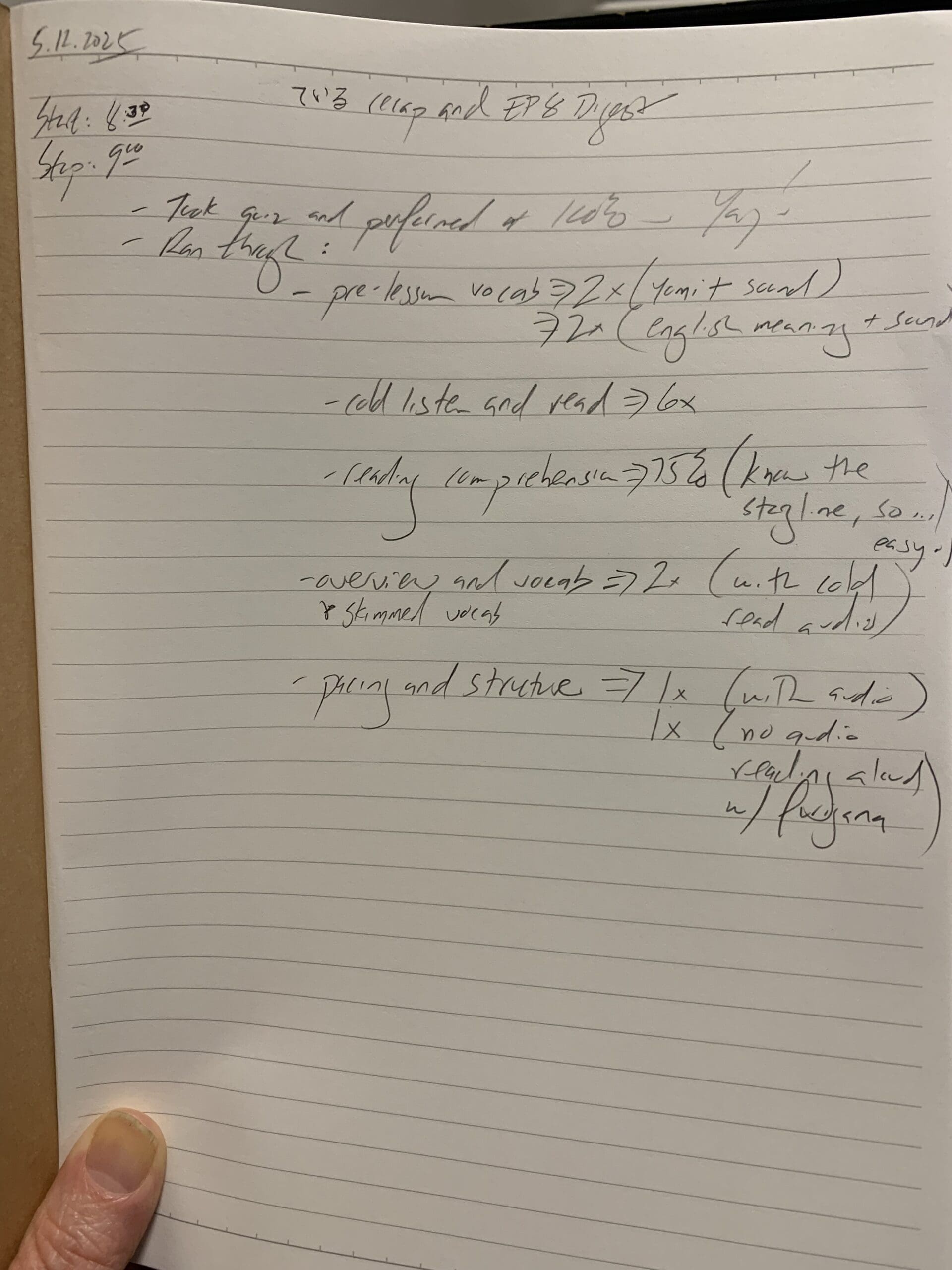Maploper: Doc Kane (self-paced program)
Kickoff Date: April 21, 2025Season ONE: Dazai Osamu, Daffodil
Day 22
May 12, 2025
Today, I’m back to the foundational course after (I think) a week focusing mostly on hiragana and kanji. Maybe it was two?
I began my lesson this evening by wrapping up the ている quiz from the last grammar module. I got a perfect score! Yay! Only one question, but it was hardly easy for me. After that, I moved on to the “Digest Module” … EP8.
Within the digest modules are the ramp up materials we include as a preface to the grammar point modules and to prepare learners for the specific story paragraph they’ll be working on at this point in the program. So, I don’t have notes, per se…, more of a checklist of what I did, and my “reps.” Kinda like a workout journal. I did well, and was pleased with some of the insights gained. Here were the big things I noticed:
1. Andy’s insistence on practicing the hiragana was wise and has paid off in spades. Why? Not only can I write them all quite well now, but I’m not pausing in my reading which helps me adjust to a proper rhythm. My pace is hardly on the mark, but the word rhythm is correct.
Re: this obvious fact about knowing the hiragana being important… I’m talking about writing the hiragana and how that paid off. If you’re landing on this post without having read prior posts, you should know this isn’t the first time I’ve been down the path of learning hiragana. They are absolutely quick to learn, and the first time I did so I did with an app called KanaTown. Back then, I think it literally took me two days to recognize them on my screen. If it’s available for your device, I’d recommend it for that reason… it’s good.
Then, for years I went on to see and read hiragana in my environment; I was hardly stranger to it. But, I would forget things, and mix up letters that looked similar. I sure as heck could not really remember any of them to actually put them down on paper once I started working in my English bubble world as a teacher here in Japan.
Following Andy and Reiko’s advice to pull out the pencil changed things in one week. Latent knowledge for sure, but pencil in hand and brain working together for the win.
2. Listening to Reiko’s cold read multiple times helps IMMENSELY with speaking rhythm, visual tracking on the page, and understanding of sentence structure. My process for this second paragraph was basically, this:First, I listened to the cold read a few times. Great. Then, I then migrated to listening to her read once more while reading the PDF of the paragraph. It was like sitting at the race track trying to look for the number of the horse you bet on without the benefit of binoculars or a television set. Impossible to keep up.
So, I switched to the Pacing and Structure Worksheet which has the sentence elements bracketed and includes furigana. It made all the difference in the world. After listening to her read and following along using the pacing and structure worksheet, I was then able to read aloud on my own with good rhythm and intonation. I also had the benefit of listening to all the vocabulary in the Airtable we create for all the words in the story as well prior to this run through. That was my first early step in learning what I was going to see and here in this module.
Reiko was in the room listening, but not watching what I was doing and surprised I was just reading the Pacing and Structure worksheet. I LOVE these worksheets. They are one-of-a-kind items, and are a core component of the Maplopo Method. They WORK.
So, those were the two biggies. Check out the photos for more on what I’m referring to…
See ya tomorrow!
D
P.S. We’re all busy, right? My work this evening actually began 27 minutes earlier than noted in my notes. See that scribble there? That’s because the little one came up to me and needed a buddy until I was rescued by Reiko once her own obligations for the evening had wrapped. It takes time and effort, and ya gotta want to learn. I have not always wanted it like I need it now. When you find that desire, you’ll know the time is right. Everyone else is asleep now… as they should be.
Time spent: @ 30 minutes (these writeups sometimes take longer to write up than the learning!)
Completed Anki deck: Yep.
Start time: 8:30pm
End time: 9:00pm


